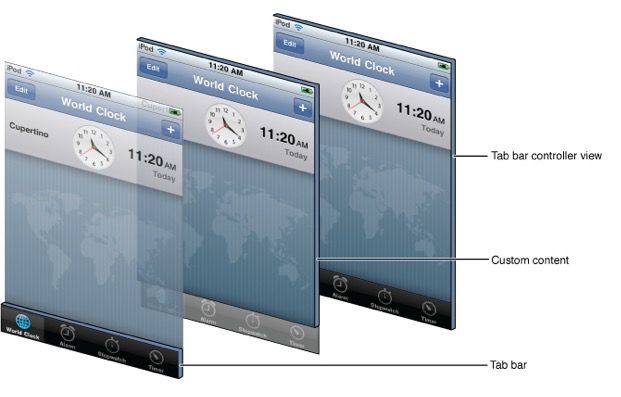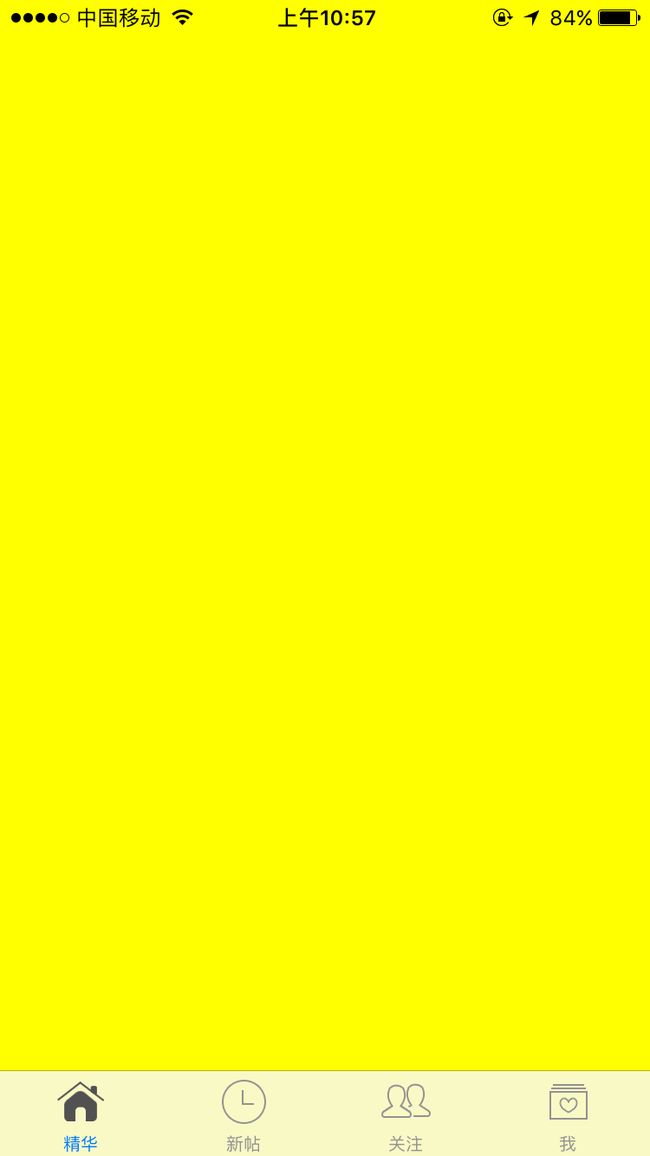简介
UITabBarController - 选项卡控制器,与导航控制器一样,也被广泛用于各种ios应用程序。顾名思义,选项卡控制器在屏幕底部显示一系列“选显卡”,这些选项卡表示为图标和文本,用户触摸它们将在不同的场景间切换。和UINavigationController类似,UITabBarController也可以用来控制多个页面导航,用户可以在多个视图控制器之间移动,并可以定制屏幕底部的选项卡栏。
借助屏幕底部的选项卡栏,UITabBarController不必像UINavigationController那样以栈的方式推入和推出视图,而是建立一系列的控制器(这些控制器可以是UIViewController、UINavigationController、UITableViewController等)并将它们添加到选项卡栏,使每个选项卡对应一个控制器。每个场景都呈现了应用程序的一项功能,或是提供了一种查看应用程序的独特方式。UITabBarController是iOS中很常用的一个viewController,例如系统的闹钟程序等,QQ也是用的UITabBarController。UITabBarController通常作为整个程序的rootViewController,而且不能添加到别的container viewController中。
与导航控制器一样,选项卡控制器会为我们处理一切。当用户触摸按钮时会在场景之间进行切换,我们无需以编程的方式处理选项卡栏事件,也无需手工在视图控制器之间切换。
UITabBarController的使用步骤
- 初始化UITabBarController控制器
- 设置UIwindow的rootViewController为这个UITabBarController
- 在UITabBarController中添加子控制器
示例代码
#import "AppDelegate.h"
@interface AppDelegate ()
@end
@implementation AppDelegate
- (BOOL)application:(UIApplication *)application didFinishLaunchingWithOptions:(NSDictionary *)launchOptions {
// 创建窗口
self.window = [[UIWindow alloc]init];
self.window.frame = [UIScreen mainScreen].bounds;
// 设置窗口的跟控制器
UITabBarController * tabbarVC = [[UITabBarController alloc]init];
// 添加子控制器
UIViewController * VC01 = [[UIViewController alloc]init];
// 设置标题
VC01.tabBarItem.title = @"精华";
// 设置默认图片
VC01.tabBarItem.image = [UIImage imageNamed:@"tabBar_essence_icon"];
// 设置选中图片
VC01.tabBarItem.selectedImage = [UIImage imageNamed:@"tabBar_essence_click_icon"];
VC01.view.backgroundColor = [UIColor yellowColor];
[tabbarVC addChildViewController:VC01];
UIViewController * VC02 = [[UIViewController alloc]init];
VC02.tabBarItem.title = @"新帖";
VC02.tabBarItem.image = [UIImage imageNamed:@"tabBar_new_icon"];
VC02.tabBarItem.selectedImage = [UIImage imageNamed:@"tabBar_new_click_icon"];
VC02.view.backgroundColor = [UIColor redColor];
[tabbarVC addChildViewController:VC02];
UIViewController * VC03 = [[UIViewController alloc]init];
VC03.tabBarItem.title = @"关注";
VC03.tabBarItem.image = [UIImage imageNamed:@"tabBar_friendTrends_icon"];
VC03.tabBarItem.selectedImage = [UIImage imageNamed:@"tabBar_friendTrends_click_icon"];
VC03.view.backgroundColor = [UIColor blueColor];
[tabbarVC addChildViewController:VC03];
UIViewController * VC04 = [[UIViewController alloc]init];
VC04.tabBarItem.title = @"我";
VC04.tabBarItem.image = [UIImage imageNamed:@"tabBar_me_icon"];
VC04.tabBarItem.selectedImage = [UIImage imageNamed:@"tabBar_me_click_icon"];
VC04.view.backgroundColor = [UIColor greenColor];
[tabbarVC addChildViewController:VC04];
self.window.rootViewController = tabbarVC;
// 显示窗口
[self.window makeKeyAndVisible];
return YES;
}
但是这样在appdelegate里面进行设置会有很多缺点:
- 底部tabbaritem都是默认的蓝色
- 添加子控制器的代码暴露在了外面
以自定义的方式实现UITabBarController
步骤:
- 新建一个继承自UITabBarController的子类
- 将这个子类设置为根控制器
- 在这个子类里面实现添加子控制器的方法
但是在这种情况下因为有系统默认的蓝色渲染,会导致选中图标selectedImage不是图片原来的样子,可以通过以下两种方式解决:
- 方法1:设置选中图片的渲染模式
// 添加子控制器
UIViewController * VC01 = [[UIViewController alloc]init];
// 设置标题
VC01.tabBarItem.title = @"精华";
// 设置默认图片
VC01.tabBarItem.image = [UIImage imageNamed:@"tabBar_essence_icon"];
UIImage * image = [UIImage imageNamed:@"tabBar_essence_click_icon"];
// 设置渲染模式 - 保持原始的渲染
image = [image imageWithRenderingMode:UIImageRenderingModeAlwaysOriginal];
// 设置选中图片
VC01.tabBarItem.selectedImage =image;
VC01.view.backgroundColor = [UIColor yellowColor];
[self addChildViewController:VC01]
-
方法2:直接在图片文件夹的属性里面进行设置 - 将render as设置成original image
由于文字和图片一样是默认的蓝色,所以也要进行设置才能达到自己想要的效果
方案一:通过setTitleTextAttributes属性设置(但是这个方法很麻烦,每次设置的时候都需要写很多代码)
- setTitleTextAttributes设置的时候是通过字典设置的,所以先搞一个字典
// 添加子控制器
UIViewController * VC01 = [[UIViewController alloc]init];
// 设置标题
VC01.tabBarItem.title = @"精华";
// 设置默认图片
VC01.tabBarItem.image = [UIImage imageNamed:@"tabBar_essence_icon"];
//设置选中图片
VC01.tabBarItem.selectedImage = [UIImage imageNamed:@"tabBar_essence_click_icon"];
// 设置文字属性
NSMutableDictionary * attrs = [NSMutableDictionary dictionary];
attrs[NSFontAttributeName] = [UIFont systemFontOfSize:12.0];
// 设置文字的前景色
attrs[NSForegroundColorAttributeName] = [UIColor darkGrayColor];
[VC01.tabBarItem setTitleTextAttributes:attrs forState:UIControlStateNormal];
VC01.view.backgroundColor = [UIColor yellowColor];
[self addChildViewController:VC01];
优化方案(appearance)
- 由于文字属性每次设置的时候代码很多很烦,所以要进行简化
- 当方法方法后面有UI_APPERANCE宏的时候,就可以通过appearance对象一次性设置
- (void)setTitleTextAttributes:(nullable NSDictionary *)attributes forState:(UIControlState)state NS_AVAILABLE_IOS(5_0) UI_APPEARANCE_SELECTOR;
- 步骤:
- 拿到那个item的apperance
- 对这个item进行设置、
- 之后所有的item都会是这个属性
- (void)viewDidLoad {
[super viewDidLoad];
// 通过appearance统一设置UITabbarItem的文字属性
NSMutableDictionary * attrs = [NSMutableDictionary dictionary];
attrs[NSFontAttributeName] = [UIFont systemFontOfSize:12.0]; // 设置文字大小
attrs[NSForegroundColorAttributeName] = [UIColor grayColor]; // 设置文字的前景色
NSMutableDictionary * selectedAttrs = [NSMutableDictionary dictionary];
selectedAttrs[NSFontAttributeName] = attrs[NSFontAttributeName];
selectedAttrs[NSForegroundColorAttributeName] = [UIColor darkGrayColor];
UITabBarItem * item = [UITabBarItem appearance]; // 设置appearance
[item setTitleTextAttributes:attrs forState:UIControlStateNormal];
[item setTitleTextAttributes:selectedAttrs forState:UIControlStateSelected];
// 添加子控制器
UIViewController * VC01 = [[UIViewController alloc]init];
// 设置标题
VC01.tabBarItem.title = @"精华";
// 设置默认图片
VC01.tabBarItem.image = [UIImage imageNamed:@"tabBar_essence_icon"];
//设置选中图片
VC01.tabBarItem.selectedImage = [UIImage imageNamed:@"tabBar_essence_click_icon"];
[VC01.tabBarItem setTitleTextAttributes:attrs forState:UIControlStateNormal];
VC01.view.backgroundColor = [UIColor yellowColor];
[self addChildViewController:VC01];
UIViewController * VC02 = [[UIViewController alloc]init];
VC02.tabBarItem.title = @"新帖";
VC02.tabBarItem.image = [UIImage imageNamed:@"tabBar_new_icon"];
VC02.tabBarItem.selectedImage = [UIImage imageNamed:@"tabBar_new_click_icon"];
VC02.view.backgroundColor = [UIColor redColor];
[self addChildViewController:VC02];
UIViewController * VC03 = [[UIViewController alloc]init];
VC03.tabBarItem.title = @"关注";
VC03.tabBarItem.image = [UIImage imageNamed:@"tabBar_friendTrends_icon"];
VC03.tabBarItem.selectedImage = [UIImage imageNamed:@"tabBar_friendTrends_click_icon"];
VC03.view.backgroundColor = [UIColor blueColor];
[self addChildViewController:VC03];
UIViewController * VC04 = [[UIViewController alloc]init];
VC04.tabBarItem.title = @"我";
VC04.tabBarItem.image = [UIImage imageNamed:@"tabBar_me_icon"];
VC04.tabBarItem.selectedImage = [UIImage imageNamed:@"tabBar_me_click_icon"];
VC04.view.backgroundColor = [UIColor greenColor];
[self addChildViewController:VC04];
}
封装 - 封装添加自定义子控制器的方法
- 由于自定义子控制器的代码很相似,所以可以进行抽取
- (void)viewDidLoad {
[super viewDidLoad];
// 通过appearance统一设置UITabbarItem的文字属性
NSMutableDictionary * attrs = [NSMutableDictionary dictionary];
attrs[NSFontAttributeName] = [UIFont systemFontOfSize:12.0]; // 设置文字大小
attrs[NSForegroundColorAttributeName] = [UIColor grayColor]; // 设置文字的前景色
NSMutableDictionary * selectedAttrs = [NSMutableDictionary dictionary];
selectedAttrs[NSFontAttributeName] = attrs[NSFontAttributeName];
selectedAttrs[NSForegroundColorAttributeName] = [UIColor darkGrayColor];
UITabBarItem * item = [UITabBarItem appearance]; // 设置appearance
[item setTitleTextAttributes:attrs forState:UIControlStateNormal];
[item setTitleTextAttributes:selectedAttrs forState:UIControlStateSelected];
// 添加子控制器
[self setupChildVC:@"精华" andImage:@"tabBar_essence_icon" andSelectImage:@"tabBar_essence_click_icon"];
[self setupChildVC:@"新帖" andImage:@"tabBar_new_icon" andSelectImage:@"tabBar_new_click_icon"];
[self setupChildVC:@"关注" andImage:@"tabBar_friendTrends_icon" andSelectImage:@"tabBar_friendTrends_click_icon"];
[self setupChildVC:@"我" andImage:@"tabBar_me_icon" andSelectImage:@"tabBar_me_click_icon"];
}
/**
* 初始化子控制器
*/
- (void)setupChildVC:(NSString * )title andImage:(NSString * )image andSelectImage:(NSString *)selectImage{
UIViewController * VC = [[UIViewController alloc]init];
VC.tabBarItem.title = title;
VC.tabBarItem.image = [UIImage imageNamed:image];
VC.tabBarItem.selectedImage = [UIImage imageNamed:selectImage];
VC.view.backgroundColor = [UIColor greenColor];
[self addChildViewController:VC];
}
自定义底部tabbar样式
如果想要在这个tabbar上面添加一个按钮(注意不是item,tabbaritem是图片在上,文字在下的格式),这个按钮和item样式不一样,占据了和item上文字加上图片的大小。由于添加到tabbar上面的item是从左到右顺序排列的,如果是直接添加一个item,那么不能达到我们想要的样式(当然,如果你是添加一个item的话,直接按照以前的方法就行了),这个时候可以通过自定义tabbar来实现。
- 由于tabbar是read-only属性,所以只能通过KVC模式跟换tabbar
步骤:
- 新建一个继承自UITabbar的类
- 在这个类里面实现初始化
- 在
layoutSubviews方法里面重新布局 - 在TabbarController里面跟换tabbar
- 虽然我们在TabbarController里面换成了自定义的tabbar,但是因为这个tabbar继承自uitabbar,所以它原来的属性和内容还在
#import "LMHTabbar.h"
@interface LMHTabbar()
/** 发布按钮 */
@property (nonatomic, weak) UIButton * publishBtn;
@end
@implementation LMHTabbar
/**
* 初始化
*/
- (instancetype)initWithFrame:(CGRect)frame{
if (self = [super initWithFrame:frame]) {
// 设置tabbar的子控件
UIButton * publishBtn = [UIButton buttonWithType:UIButtonTypeCustom];
[publishBtn setBackgroundImage:[UIImage imageNamed:@"tabBar_publish_icon"] forState:UIControlStateNormal];
[publishBtn setBackgroundImage:[UIImage imageNamed:@"tabBar_publish_click_icon"] forState:UIControlStateHighlighted];
[publishBtn sizeToFit];
[self addSubview:publishBtn];
self.publishBtn = publishBtn;
}
return self;
}
/**
* 重写布局子控件的方法进行布局
*/
- (void)layoutSubviews{
[super layoutSubviews];
CGFloat width = self.frame.size.width;
CGFloat height = self.frame.size.height;
// 设置发布按钮的frame
self.publishBtn.center = CGPointMake(width * 0.5, height * 0.5);
// 设置其他的UITabBar的frame
CGFloat buttonY = 0;
CGFloat buttonW = width /5;
CGFloat buttonH = height;
NSInteger index = 0;
for (UIView * button in self.subviews) {
// 判断 - 只有是UITabBarButton的button才进行布局(也就是tabbar上面的精华、新帖、关注、我这四个按钮) 而发布按钮不是UITabBarButton,就不进行布局
// 由于UITabBar是苹果官方私有的, 所以不能直接设置
if (![button isKindOfClass:NSClassFromString(@"UITabBarButton")]) continue;
// 计算按钮的x值
CGFloat buttonX = buttonW * ((index > 1) ? (index + 1): (index));
button.frame = CGRectMake(buttonX, buttonY, buttonW, buttonH);
// 索引增加
index ++;
}
}
@end




